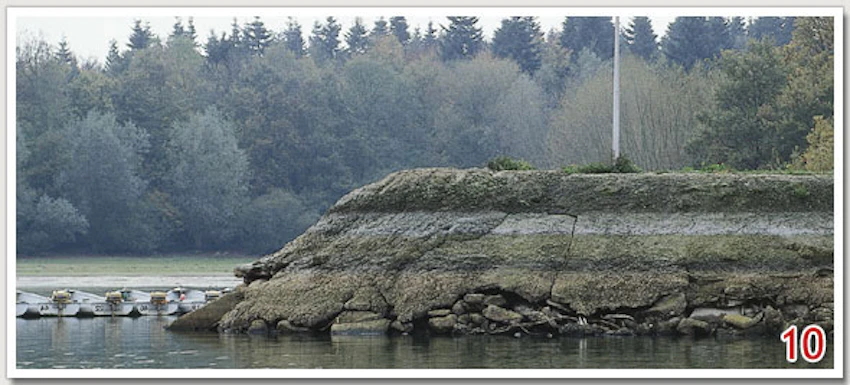Just 15 miles from the M25 and 35 miles from the centre of London, Hanningfield in Essex is justifiably famous for its ability to grow-on large rainbows and specimen browns. Its protected artificial banks provide good bank fishing in northerly or easterly winds when other reservoirs suffer. Fishery regulars COLIN DAVIS and MIKE MARSHALL outline the best bank fishing possibilities.
TACKLE AND FLIES FOR THE BANK
THE best all-round outfit is a middle to tip- actioned 9ft 6in #7 rod; large diameter reel such as a Leeda Dragonfly 395; WF#7 lines types F, I and ST DI-7; Airflo Sightfree 8lb fluorocarbon leader and leader rings; large net with a long handle.
Regarding fishing methods and flies, the following four systems will suffice:
- Wind mostly behind: Use a WF floating line and two size 12 heavy Superglue Buzzers, seven feet apart on a 15/16ft leader. Try an 18-inch dropper length and a goldhead Olive Long Tail size 10 on the point at times. Allow the flies to sink for up to a minute, then retrieve by figure of eight very slowly. This delicate system produces a high proportion of grown-on, hard-fighting trout.
- Cross wind: As above but swap the floater for an Airflo WF slow inter-mediate clear glass.
- General conditions: Use an Airflo DI-7 shooting head, leader four to 10ft long, Boobies size 10 and 8 with short and long tails. Retrieve by FOE to long pulls and anything between. Best results to be decided by experiment ‘on the day’.
- Evening rise: Use a WF floating line, 10ft leader, two size 10 Wingless Wickhams 10 five feet apart. Cast in front of a rising fish, allow to just sink, then draw back with a slow pull.
UNDERSTANDING THE WIND
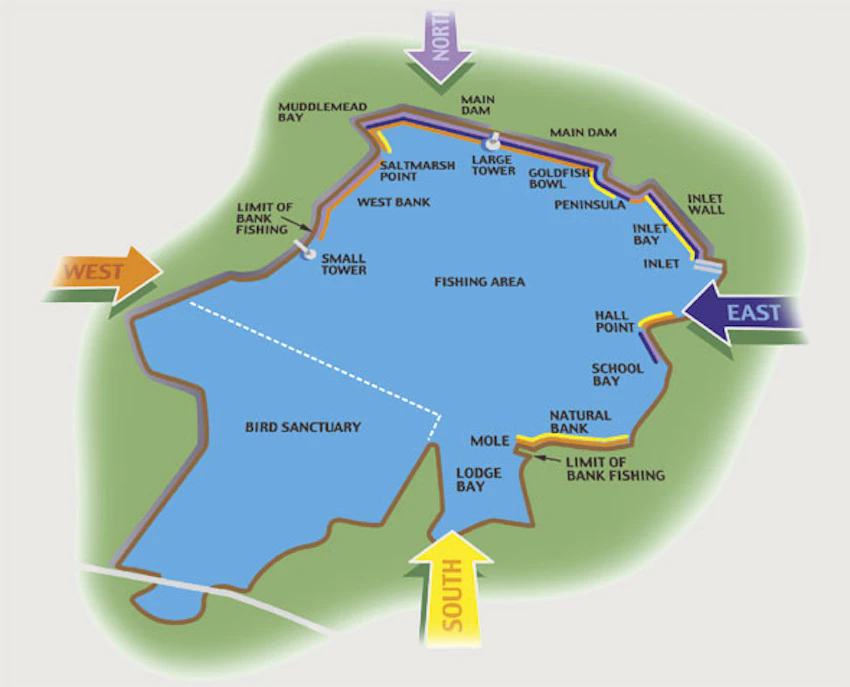
DIRECTION
BEST AREAS
N
West Bank, Middlemead Bay, Main Dam, Goldfish Bowl, Peninsula, Inlet Bay, Hall Point
E
Middlemead Bay, Main Dam, Goldfish Bowl, Peninsula, Hall Point
S
Middlemead Bay, Peninsula, Inlet Bay, Hall Point, Mole, Natural Bank
W
West Bank, Middlemead Bay, Peninsula, Hall Point, Natural Bank
SW
West Bank, Middlemead Bay, Hall Point, Natural Bank, all North Bank
MOST waters evolve naturally as fisheries and Hanningfield is no exception.
The biggest change for the bank angler since it first opened for trout fishing in 1958 is less bank available for wading, particularly at the back-end, due to a more stable water supply. Where the water level used to drop by up to 15 feet during the fishing season, exposing miles of wadeable bank, it now drops just eight or nine feet by the end of October, as can be seen in the accompanying photographs. This is a limiting factor, but some of the most important wading areas still come into play.
As a result of an environmental problem, Hanningfield no longer has a working fish farm. This used to concentrate a sizeable population of very large fish in just a small area. Now these larger fish are much more widespread, to the benefit of the bank angler.
When it comes to growing-on large trout, Hanningfield is second to none and provides a huge and varied larder for the most-discerning fish. Bloodworms, which transform to buzzers, are present year round, hatching best from April to June and again in September and drawing large numbers of swallows and swifts.
There are huge numbers of sedge larvae (stickflies) on the bottom which hatch in the evenings at roughly the same times as buzzers. Although they hatch in large numbers, only the larvae appear in quantity in the marrow spoon while pupae and adults are largely ignored.
Other bottom food to be found in vast numbers are hoglice and snails, which cause selective feeding habits in some trout. But the most prolific food supply is daphnia, which some trout live and grow on alone. During an evening rise, it’s easy to believe trout are feeding on insects when, in fact, the marrow spoon reveals only daphnia.
Hanningfield has only a very small coarse fish population, so fishing for fry feeders is generally unproductive. However, there are sometimes worthwhile numbers of sticklebacks at the back-end in Lodge Bay and along the Natural Bank, as well as good numbers of corixae. The trout, some very large, seem to enjoy these delicacies.
It is little wonder that 2lb stocked rainbows grow fast - the record was 24lb 1oz in 1998 and 21lb 9oz for 2002 so anglers are able to catch what are effectively wild trout.
About 60 per cent of the bank fishing is concrete wall, made more attractive because much of it is tree lined. It provides long lengths of sheltered fishing over deep water that is relatively unaffected by weed growth. If the water level drops significantly, though, some shallower areas do suffer badly through weed growth from June until the end of August. Standing on sloping walls is not permitted so metal platforms, which are comfortable to fish from, are placed at 40-yard intervals.
The water at Hanningfield is crystal clear at times, helped by the concrete banks which do not produce mud stains in windy conditions. But as on many lowland waters there are algal blooms. In March and April a brown stain becomes apparent, while in July and August green algae can appear in quantity. Both are unpleasant for the angler to fish in, but do not appear to affect the fish in any way.
Contrary to some opinions but established through many years of experience, this water fishes best when the wind is behind the angler. The most productive area is the piece of Main Dam between the Middlemead car park and the large tower.
Pay attention while your flies are sinking as trout often take ‘on the drop’. And keep your fingers away from the reel when a grown-on trout takes off – or you could find yourself suffering sore knuckles.
A clockwise tour of the main bank fishing locations, starting with the West Bank directly opposite the Lodge:
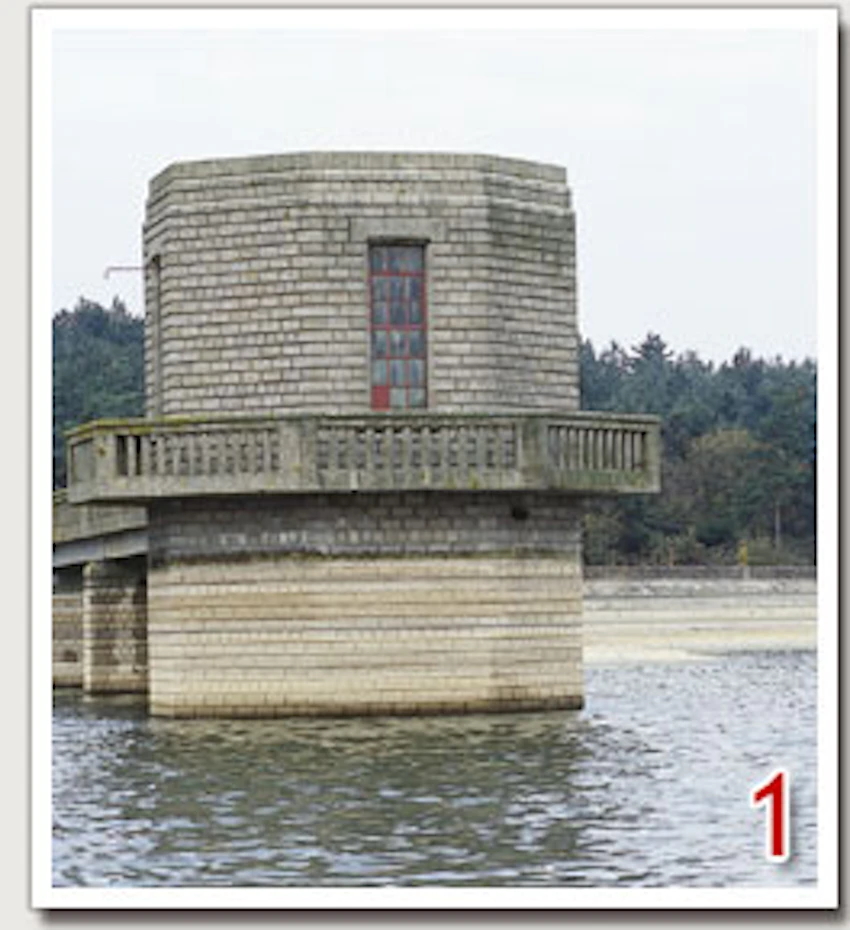
1. WEST BANK
This relatively straight stretch of dam starts adjacent to the small tower, where there is a marker showing the limit of bank fishing. Depth varies from 10 to 14ft over a plateau 150 yards wide which becomes weedy from June to the end of August, although it can die earlier. Fishing can be very good until June in a light south-westerly, or west and north winds of any strength. The same can be said for September onwards, but depends on the water level since, being shallow so far out, trout will not hold there.
As it is a half-mile walk from the Middlemead car park, check first on the water level. If it is any more than four feet down, don’t risk the long walk. The shelter of the tower gives the prospect of an evening rise in a south-westerly in May or June.
TOP TIP: Best in April and May in a light south-westerly with an intermediate line
BEST TIMES: March to the end of May and September onwards if deep enough
WIND EFFECT: Best in south-west, west and north winds
2. SALTMARSH POINT
Typical of most points, there are areas either side of this where the wind-driven currents slacken and harbour food, particularly daphnia. These slacks,frequently with associated wind lanes, occur when northerlies or south-westerlies blow. Within casting range the water is about 14 feet deep at full height sloping gradually into deeper water. Consequently, fish will confidently remain in the area. Weed can be a problem. Watch for strong undercurrents. An intermediate will start drifting one way, then reverse as it sinks.
TOP TIP: Best in April and May in a light south-westerly with an intermediate line, or a DI-7 line
BEST TIMES: March to end May and September onwards
WIND EFFECT: Best in south-west, west and north winds
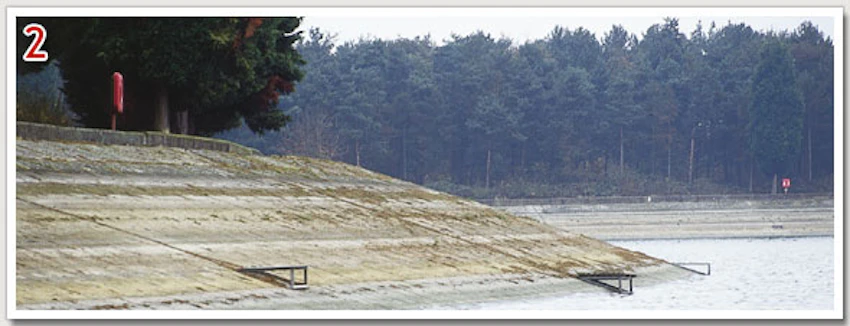
3. MIDDLEMEAD BAY
Most popular bank fishing area on the whole water, fishing well in almost any wind, the exception being a strong south-easterly which makes the bay too rough. The water is about 14 feet deep at full height, sloping into deeper water, holding a resident population of trout through the season.
Weed can be a problem in places in July and August, although Geriatrics Corner does not weed up even though it may become shallower. This bay is very productive and bank anglers often outfish those in boats by more than five to one.
When the wind drops during a mild, cloudy evening in May or June, it can produce a good evening rise.
TOP TIP: Fish Geriatrics Corner with a floating line in May and June
BEST TIMES: All season
WIND EFFECT: Fishing possible somewhere in the bay in all winds except strong south-easterlies
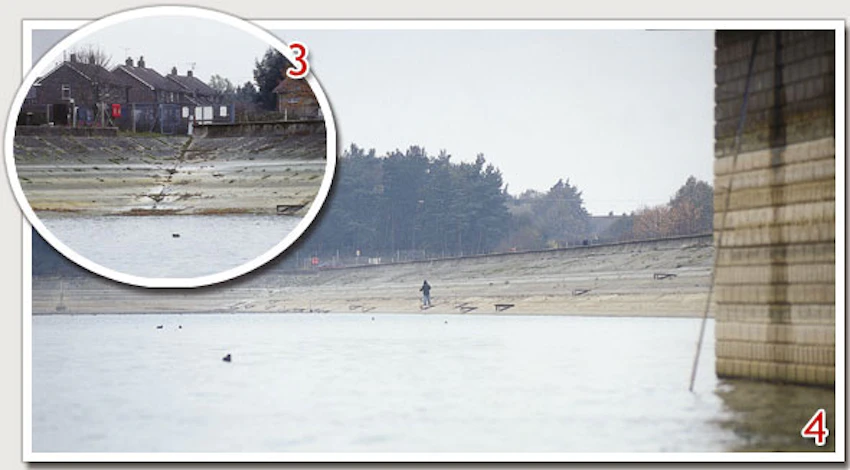
4. MAIN DAM
Straight length of dam wall about half a mile long starting and finishing with depths of about 15 feet at maximum casting range, deepening in the centre to about 25 feet.
The bottom keeps sloping into deeper water throughout so trout always feel safe and will often come in quite close throughout the season. Even with bright sunlight and clear water, trout can almost always be caught, especially with Boobies.
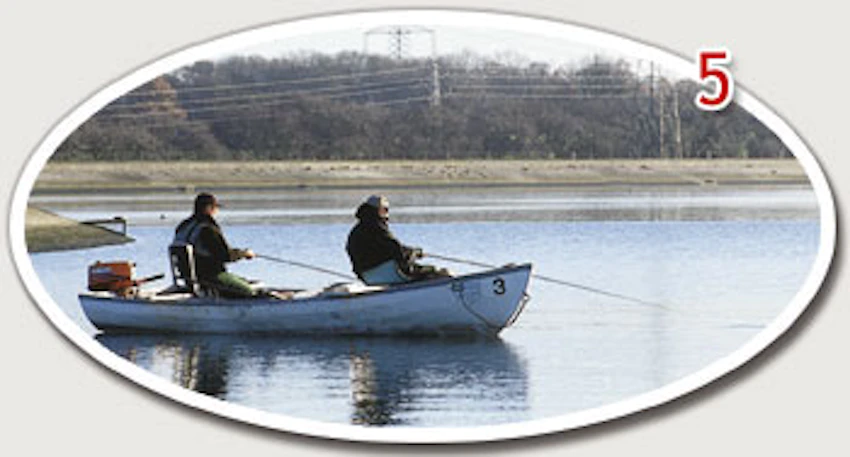
This dam fishes well in northerlies or north-easterlies, so you can fish in shirt-sleeves in the shelter of the wall when everyone else is shivering in the cold wind. However, it is not the place to be in a strong south-westerly striking at right angles.
TOP TIP: With the wind offshore and dull, use a floating line. If it’s sideways, use an intermediate. If bright, use the DI-7 and a dark Booby with flash in the dressing
BEST TIMES: All season
WIND EFFECT: Fishes best in northerlies and easterlies, but will fish in light westerlies, although casting is tricky for a right-hander
5. GOLDFISH BOWL
Formed by the end of the Main Dam and the projection of the Peninsula. Depth similar to the Dam. The corner formed is a collection point for daphnia in westerlies and trout take full advantage. When it’s warm in an easterly wind, expect a good evening rise in the calm water. The start of the ripple along the dam will produce an excellent hatch of buzzers. It pays to be fairly sure of your facts since this end of the Dam is a long walk and is best reached from the Inlet car park.
TOP TIP: In a north-east or east wind, fish the floating line with Buzzers
BEST TIMES: All season
WIND EFFECT: Will fish in any wind except strong southerlies or south-westerlies
6. PENINSULA
This projection between the Main Dam and Inlet Wall used to be the site of a trout rearing unit which is still there, but ‘mothballed’. Due to its shape and position, stronger currents pass the extreme end, with slack water and wind lanes on either side, depending on wind direction. The best are formed by north-westerlies and south-easterlies.
Water is not deep at the outer end of the Peninsula with a depth of about 12 feet at casting range, nor does it slope out into deep water. However, it is a very productive area from March to May and September onwards, with weed a problem in between.
Even after the water drops, bank anglers there will catch lots of trout when boat anglers further out catch very little. This may well be because the currents are between two areas of deep water off the Main Dam and in Inlet Bay, with the trout ‘in transit’. The Peninsula is reached after quite a long walk from the Inlet car park.
TOP TIP: When calm, fish the floating line. In side winds, fish the intermediate line and if bright, fish the DI-7 line
BEST TIMES: March to May and September onwards
WIND EFFECT: Will fish in one part or another in any wind, except strong south-westerlies
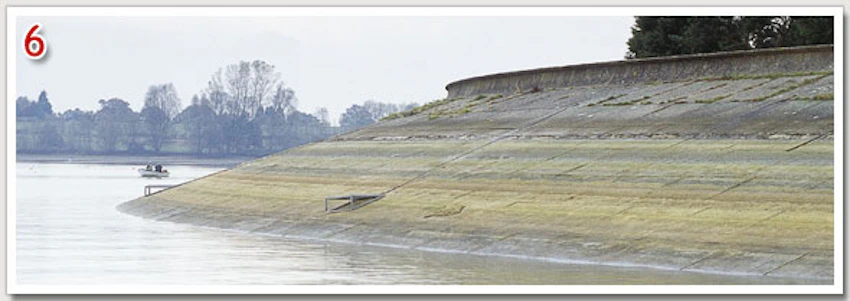
7. INLET WALL
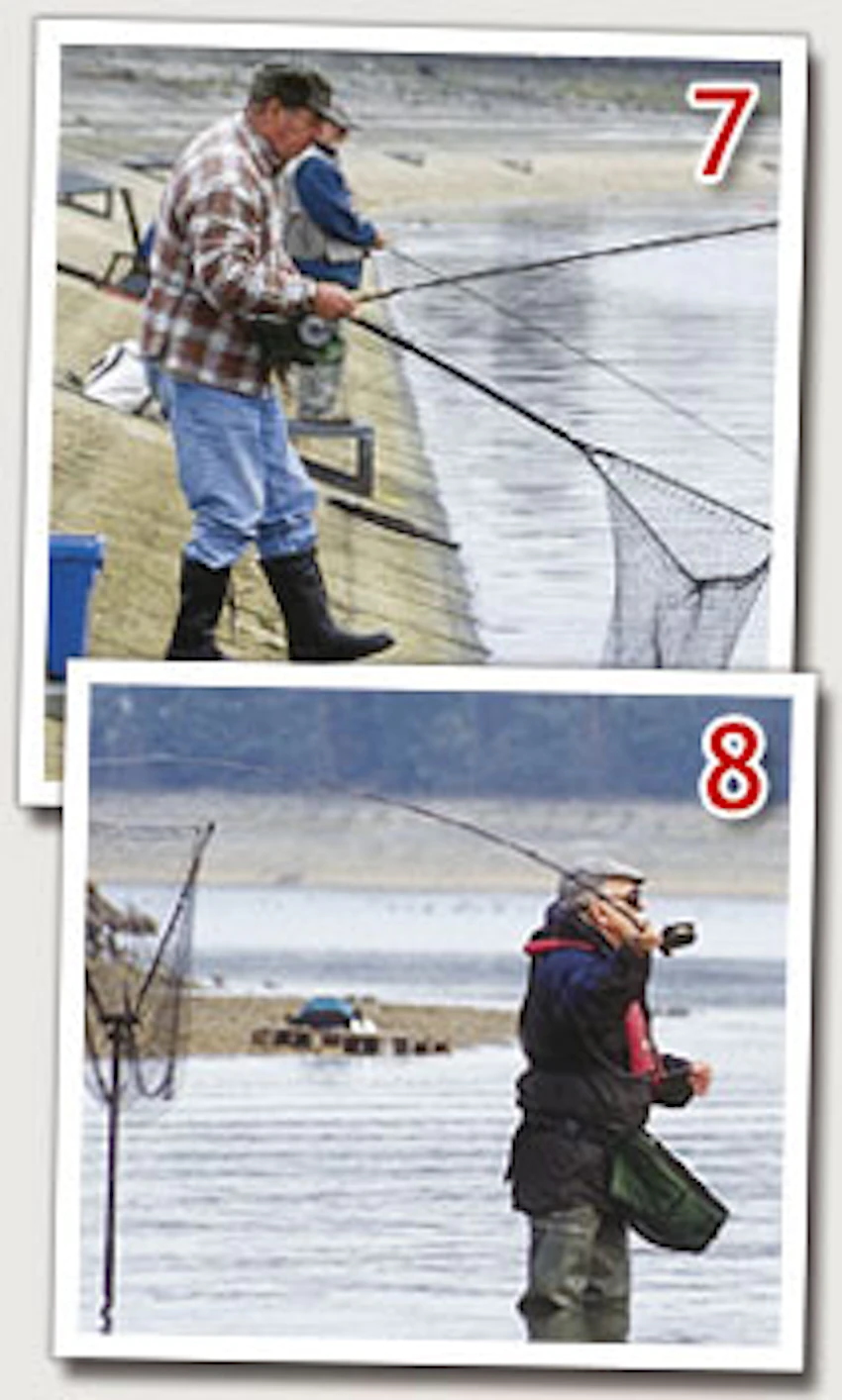
This section of wall has quite deep water close in which slopes gradually deeper, thus holding trout in any conditions. It fishes best in easterlies and northerlies, but can also be quite good in southerlies. Occasionally there are periods of very light south-westerlies, which blow straight into Inlet Bay and fill it with daphnia. When this happens, orange or black and green Boobies do very well.
TOP TIP: The middle 60 to 70-yard section is the most consistent, with floating line or DI-7 line best
BEST TIMES: All season
WIND EFFECT: Best in easterlies, northerlies and casting into light south-westerlies
8. HALL POINT
This point is faced with loose rocks and stones so fishing out of the water is safest, particularly as the bank shelves steeply into deep water. Quiet water and wind lanes are formed on either side of the point, depending on wind direction. Often this quite limited location will fish very well from September onwards when the water cools down, and is reached by a bankside path from the Inlet car park.
TOP TIP: Fish a floating line or an intermediate line with a silverhead White Longtail as an alternative.
BEST TIMES: March to May and very best from September onwards.
WADING: Not advisable until the water drops below the rocks - about six feet down.
WIND EFFECT: Will fish somewhere in any wind except West, but North is very tricky.
9. NATURAL BANK
This short length of wading bank is within easy reach of deep water so trout move confidently along it. It will fish well in South-west, South and East winds, but any strength of wind from other directions tends to stir up the bottom and cause discolouration. This tends to be a back-end location due to the need for the water level to drop. The rangers will inform you when this happens.
The regular presence of corixae and stickle- backs is much appreciated by the trout and they will feed there regularly, particularly early in the morning. Access is easy from the Lodge car park.
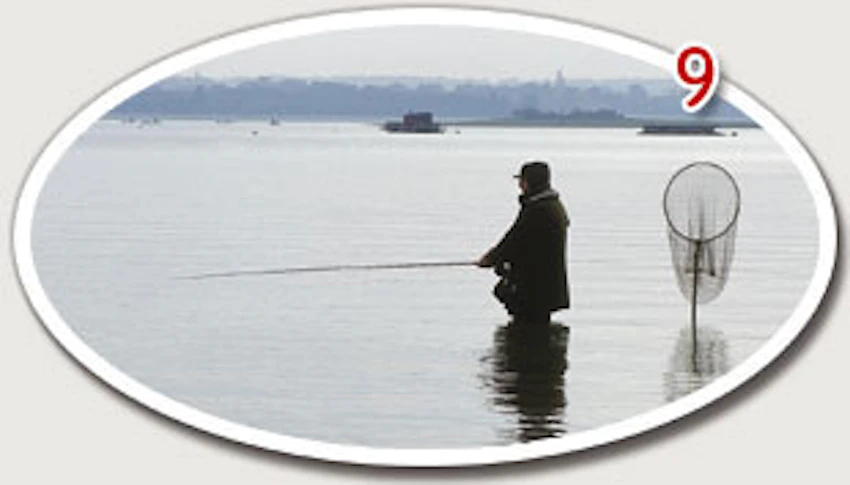
TOP TIP: Fish floating line with a Corixa 12 on the point instead of a Buzzer or intermediate line with a silverhead White Longtail on the point.
BEST TIMES: When water level permits - usually September onwards.
WADING: Easy, although quite soft in one or two places.
WIND EFFECT: Best - South and South-west.
10. MOLE
This large rock and concrete jetty was built to protect the boat dock, but it also provides some easy bank fishing in deep water, always with the chance of a large trout since they lurk among the rocks at its base. Fishing takes place from the top when the water level is high, and when it drops there is a convenient ledge lower down to fish from. A very long- handled landing net is available on request. Due to the proximity of the boat dock one thing is certain, you will never feel lonely, but the trout do not seem to mind all the comings and goings.
TOP TIP: Fish DI-7 line and Booby right to the base of the Mole and trout often take just as you lift up. Systems (1) and (2) work well here.
BEST TIMES: All season.
WIND EFFECT: Best in South-west, South or East winds.
